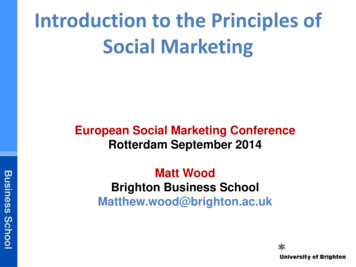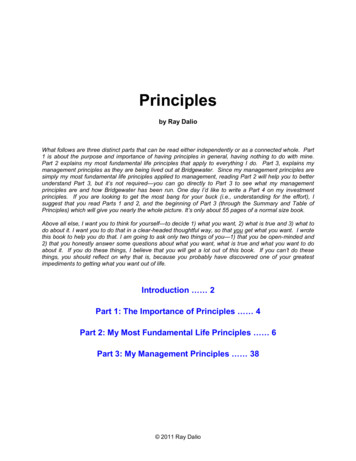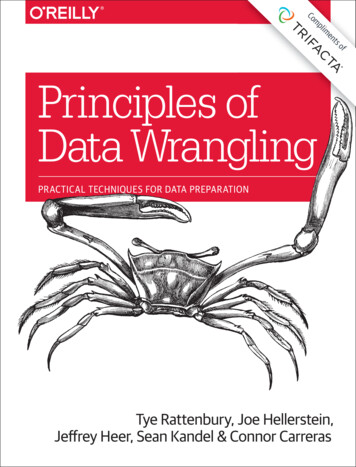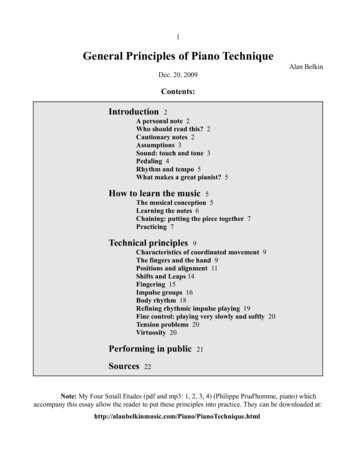
Transcription
Introduction to the Principles ofSocial MarketingEuropean Social Marketing ConferenceRotterdam September 2014Matt WoodBrighton Business SchoolMatthew.wood@brighton.ac.uk
Introduction to the Principles of SocialMarketingSession Aim: To provide an overview of the key principles of social marketingLearning Outcomes: By the end of the session we will be able to:– Explain the basic principles of social marketing– Explain academic definitions of marketing and social marketing, andthe differences between the two– Identify social marketing in practice – what it is (and what it’s not)?!
A Definition of MarketingMarketing is the managementprocess responsible for:IdentifyingAnticipating andSatisfyingCustomer requirements profitablyC.I.M.
The Marketing Concept“The central idea of marketing is of amatching between a company’scapabilities and the want ofcustomers in order to achieve theobjectives of both parties.”The marketing concept, as opposed to the marketingfunction, implies that all the activities of an organisationare driven by a desire to satisfy customer needsMcDonald, 2007
And Social Marketing?
Social Marketing Defined‘The systematic application of‘Social Marketing is concerned with the application ofmarketing knowledge, concepts and techniques toenhance social as well as economic ends. It is alsoconcerned with analysis of the social consequences ofmarketing policies, decisions and activities’Lazer and Kelley, 1973‘Social marketing is a process that appliesmarketing principles and techniques tocreate, communicate, and deliver value inorder to influence target audiencebehaviours that benefit society (publichealth, safety, the environment, andcommunities) as well as the target audience’Kotler and Lee, 2008marketing alongside otherconcepts and techniques,to achieve specific behaviouralgoals, for a social or public good’French, Blair-Stevens, 2006“Social Marketing seeks to develop andintegrate marketing concepts with otherapproaches to influence behaviours that benefitindividuals and communities for the greatersocial good.”Social Marketing practice is guided by ethicalprinciples. It seeks to integrate research, bestpractice, theory, audience and partnershipinsight, to inform the delivery of competitionsensitive and segmented social changeprogrammes that are effective, efficient,equitable and sustainable.Consensus definition: ISMA, ESMA, AASM 2013
Social Marketing: three key factors A set of tools or technologies adapted from commercial ortraditional marketing and applied to behavioural issues Social marketing – via the core marketing concept (orphilosophy) – way of approaching a specific issue with afocus on the audience’s perspective Desire for socially just and fairer society “for social good”
Why Social Marketing?‘It would be easy to give the public information andhope they change behaviour but we know thatdoesn’t work very satisfactorily.Otherwise none of us would be obese, none of uswould smoke and none of us would drive likelunatics’Ian Potter, DirectorNew Zealand Health Sponsorship Council,New Zealand Herald, June 2007
How does Social Marketing Work?8 Benchmark criteria:1.Customer orientation2.Clear focus on behaviour3.Informed by behavioural theory4.Insight – what moves/motivates?5.Exchange – increase benefits/reducebarriers6.Competition – internal/external7.Segmentation – targets specific audience groups8.Mix of methods – information/services/rules National Social Marketing Centre
Core Principles: Customer OrientationCommunications & message-based approachcrafting‘our messages’accurate / relevant /clearcommunicatingthe messagescreative / clever / funny / impactful /interesting / attention grabbing / etcCustomer-based social marketing approachunderstandingthe customergenerating‘insight’what ‘moves & motivates’directly informing intervention options(intervention mix & marketing mix)Starts with the customer and what’s important to them
Core Principles: Focus on Behaviour Set clear behavioural goals Evidence-based approach, informed by theory (from a rangeof disciplines) Typically want people to do one of four things:– Accept a new behaviour e.g. use mosquito net over bed– Reject a potentially undesirable behaviour e.g. smoking– Modify a current behaviour e.g. for those with multiplesex partners, use a condom– Abandon an old, undesirable behaviour e.g. excessivealcohol useKotler and Lee, 2009
Core Principles: People-first mindset In-depth understanding of audiencemotivations and deep truths or insight Systematic audience understanding Targeting is key (segmentation) Recognition that the beneficiary is theindividual, group or society as a whole – notthe sponsoring organisation
Core Principles: Exchange – What’s In It For Me?e.g. givingchildren healthysnacks in Benefits Costs Value(relative to competition)
Core principles: The Traditional Marketing Mix - 4PsProduct What does the customer get? What’s being offered?Price How much will it cost? (not just financially, could alsobe time, effort, emotional costs etc)Place How are we going to get this to the customer?Where is it available?Promotion What methods shall we use to communicate? How can we reach the customer?
Extra “Ps” Classic commercial marketing “4 Ps” – usefulstarting point; Extra “Ps” that some marketers have added:– Proposition– Partnerships– Purse-strings– Policy– People
Core Principles: Evidence and Evaluation Evidence-driven Results-focused Evaluate, evaluate, evaluate– Benchmark– Process and its efficiency– Outcome and impact measures– Measure success (ROI?)
Road Crewhttp://www.youtube.com/watch?v gOfbL3Fh8k
The Social Marketing Debate The 4 Ps? Or more or something else? Theory?Sustainable?Effective?Evidence-based?Up, down and mid-stream social marketingSocial marketing as co-creation of services?Behavioural economics – friend or foe?!Fun, easy, popular . (Bill Smith, AED)– http://www.youtube.com/watch?v 2lXh2n0aPyw (piano stairs)
Piano Stairs What is the behaviour that the creators hopedto address? Who is the audience? What came first, the idea or the insight? Is this a good example of social marketing?
The Stairs – informative discussion or adistraction? “We care about population health – so how many stairs like this wouldwe have to create to have a population-based health benefit?” “Talk about a great “place” strategy” “And this ad shows us what happens when you put the kids incharge. You get a great insight with no direct practical application. Youget lots of imaginative implications, a giggle and lots of hard work still todo if you are to make a difference in the world” “It does seem unlikely that this effort would achieve widespread, longterm behaviour change to the degree an integrated, dedicated socialmarketing campaign might. But the video doesn't claim to do so - it'sclaim, literally, is ‘Fun can obviously change behaviour for the better.’” “When you have been crying in the wilderness that social marketing isnot just about messages but about transforming the environment tomake difficult behaviour fun, easy and popular, what a joy to receive thisexample.”[With thanks to the members of the social marketing listserve moderated by Andreasen(Georgetown University)[Oct 2009]
marketing policies, decisions and activities’ Lazer and Kelley, 1973 ‘The systematic application of marketing alongside other concepts and techniques, to achieve specific behavioural goals, for a social or public good’ French, Blair-Stevens, 2006 ‘Social marketing is a process that applie











